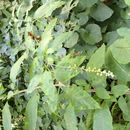Comprehensive Description
provided by North American Flora
Phytolacca americana L. Sp. PI. 441. 1753
Phytolacca decandra L. Sp. PI. ed. 2. 631. 1762. Phytolacca vulgaris Crantz. Inst. 2: 484. 1766. ^Phytolacca americana lancifolia H. Walt, in Engler, Pflanzenreich 4 83 : 55. 1909.
A glabrous succulent herb, 1.5 m. or more high, with an unpleasant odor, the large perennial parsnip-like root poisonous; leaf-blades oblong-lanceolate, ovate-lanceolate, or ovate, 10-30 cm long, 3-13 cm. broad, acute or acuminate at both ends, often mucronate; petioles slender, 1-6 cm. long, grooved above; racemes pcduneled, S-30 cm. long, nodding in fruit; pedicels glabrous or puberulent, often reflexed, 6-12 mm. long, each with a subulate-lanceolate bract at its base and usually 2 similar ones above; sepals greenishwhite or pinkish, oval to suborbicular, 2.S-3.3 mm. long, 1.9-3 mm. broad; stamens 9-12, commonly 10, shorter than the sepals; filaments subulate, 2-2.5 mm. long; anthers oblong, about 1 mm. long; ovary 10-carpellary, green, the carpels connate; styles recurved; berry dark-purple, depressed, 9-1 1 mm. in diameter; seed suborbicular, 3-4 mm. long, black, shining.
Type LOCALITY: Virginia.
Distribution: Maine and Ontario to Minnesota. Texas, and Georgia; Mexico (?); Bermuda. Naturalized in Europe.
- bibliographic citation
- Percy Wilson, Per Axel Rydberg. 1932. CHENOPODIALES. North American flora. vol 21(4). New York Botanical Garden, New York, NY

